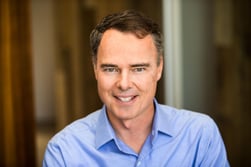Sierra Ventures 2022 CXO Summit Recap

Sierra Ventures’ 17th Annual CXO Summit brought together over 50 F2000 CXOs, two large public company CEOs, and a number of fantastic entrepreneurs to discuss key industry trends. Given the macro environment, everyone was very curious about CXO spending and our poll showed that 52% of CXOs in attendance mentioned that their 2022 technology budgets increased over 2021 and many are clearing paths for internal innovation.
5 important themes from the event:
- The Next Evolution of the Internet is Immersive
- Enterprise Spending Shifts in a Post-Pandemic World
- Today’s Skills Expire Faster Than Your Car Lease
- Infrastructure Transition from Private Cloud to Multicloud
- Will Low Code / No Code Disintermediate IT?
The Next Evolution of the Internet is Immersive
John Riccitiello, CEO of Unity ($U), gave an insider’s view of business applications in the Metaverse. Riccitiello has a ringside seat to the evolution of the internet and how big brands have had to learn to adopt and adapt. Hundreds of enterprise organizations work with Unity to power branded Metaverse experiences.

John Riccitiello, CEO of Unity
One of the most contested topics in the media is what the Metaverse is and what it is not. Riccitiello stated a clear blueprint for identifying the next generation of the internet, which must include the following:
- Always be real-time
- Mostly be 3D
- Mostly be interactive
- Mostly be social
- Mostly be persistent
The most concrete example of how brands will adopt the Metaverse will be their website. Gone are the days of static content, 2D imagery, and lists of FAQs. The future will be real-time interactive 3D experiences that are social and persistent.
“Of all of the components, real-time is the most important. This media is alive and the next event we experience is not predestined but spontaneously arises out of our actions and those of others we interact with.”
Riccitiello is confident that by the end of this decade almost every website will meet this definition.
Today’s Skills Expire Faster Than Your Car Lease
Dr. Gabriella Rosen Kellerman, Chief Product Officer of enterprise learning unicorn, BetterUp, has an extensive background in psychiatry, digital health, and behavioral changes in technology.

Dr. Gabriella Rosen Kellerman, Chief Product Officer at BetterUp
The last few years have fueled the need for organizations to be introspective and acknowledge the acceleration of changes in the workforce. 60% of our CXO attendees said they currently care more about leadership development than technical upskilling.
Management today is different than in the recent past because employees experience change and need to respond to it faster than any manager can be expected to track. Successful managers lead teams that are ready to respond smartly even without being able to consult with their boss. Managers need to ensure team readiness for this type of performance rather than reviewing activity. That is a very different type of role.
Infrastructure Transition from Private to MultiCloud
IDC is forecasting cloud infrastructure spending in 2022 to grow 22% compared to 2021 to $90.2 billion. Dave McJannet, CEO of HashiCorp ($HCP), joined us to highlight the incredible innovation that is coming to modernize infrastructure. HashiCorp is a leader in providing open-source tools and commercial products that enable businesses to provision, secure, run, and connect cloud-computing infrastructure. HashiCorp’s customers consist of one-quarter of the Fortune 2000.

Dave McJannet, CEO of HashiCorp
McJannet noted at a high level that the infrastructure transition has gone from all private data centers to everything in the cloud, to now the adoption of multi-cloud as the steady state. Almost all enterprises will end up having more than one cloud partner who will increase the need for an operationally consistent approach and the capability to apply governance to the adoption.
Scott Yara, Co-CEO of Astronomer, whose Apache Airflow is downloaded 8M times a month and is now one of the most widely adopted and popular open-source projects in the world, joined the conversation. Yara pointed out that we are building off a decade of cloud adoption and the previous technology is code generation tools that don’t lend themselves to be version controlled and subject to the same CI/CD processes.
“It is very clear that if we are going to get to the next level of productivity around data processing, we need to embrace the same set of principles that we have for software development.” – Scott Yara
Tenry Fu, CEO of Spectro Cloud, which focuses on enterprise Kubernetes management, joined to also chime in on the modern infrastructures. Fu noted that they see edge locations becoming the next phase of the multi-cloud because more and more data is generated in edge locations and organizations need to leverage low-code tools to compute and process all this data.
These new infrastructure groups will have to adopt this excess code philosophy in order to allow their systems to be more agile and descriptive which enables them to easily debug as they scale horizontally across different cloud and on-premise environments.
Will Low Code/No Code Disintermediate IT?
Gartner predicts that by 2025, 70% of new applications developed by enterprises will use Low-code/no-code technologies. These tools will make processes easier than today and democratize the ability to create new software applications, making it possible for distributed departments to move faster and, potentially, become more productive.
Wendy Pfeiffer is the CIO of Nutanix, the technology juggernaut that started the hyper-conversion movement. She spoke about her reasoning for shifting Nutanix to low code/no code adoption during the pandemic.
“Really, what everyone was looking for was improved interactive design; one that is more appropriate for millennials and GenZ workers who live in a consumer technology world.”
Nutanix wanted to disintermediate IT and directly configure and personalize the applications and environments they were using. One of the advantages was that it quickly gave the team an incredibly rich data set which was then used to form interactive designs and enable employee productivity.
Ari Studnitzer, managing director of The Chicago Mercantile Exchange (CME), the world’s leading and most diverse derivatives marketplace, touched on how CME stopped looking at technology as a service provider and started looking at it as an enabler. By leveraging 3rd party low code/ no code tools they were able to allow the business to get access to the data more efficiently and to get access to the tools to convert that data into information.
Guillermo Rauch, CEO of unicorn, Vercel, which empowers organizations to iterate quickly on front-end initiatives, mentioned how in the past with low code/no code you were able to move fast but the content was static. Now we are in the midst of real dynamic next-generation development that allows you to move fast and iterate quickly.
“My take is that Javascript has really been taking over the world. It is the number one language in terms of how many devices can run this code,” said Rauch.
As we head into the final stretch of 2022, technical and managerial innovation continues to weigh on the enterprise mind. It was encouraging to see our CXO leaders eager to adopt new technologies and adapt to the choppy waters.
